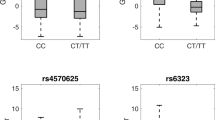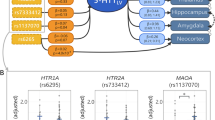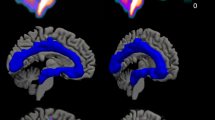Abstract
Brain regional serotonin synthesis can be estimated in vivo using positron emission tomography (PET) and α-[(11)C]methyl-L-tryptophan (11C-AMT) trapping (K*) as a proxy. Recently, we reported evidence of lower normalized 11C-AMT trapping in the orbitofrontal cortex (OBFC) of subjects meeting the criteria for an impulsive and/or aggressive behavioral phenotype. In this study, we examined whether part of the variance in OBFC serotonin synthesis is related to polymorphisms of the gene that encodes for the indoleamine's rate-limiting enzyme in the brain, tryptophan hydroxylase-2 (TPH2). In all, 46 healthy controls had PET 11C-AMT scans and were genotyped for 11 single-nucleotide polymorphisms (SNPs) distributed across the TPH2 gene and its 5′ upstream region. Several TPH2 SNPs were associated with lower normalized blood-to-brain clearance of 11C-AMT in the OBFC. Dose–effect relationships were found for two variants (rs6582071 and rs4641527, respectively, located in the 5′ upstream region and intron 1) that have previously been associated with suicide. Associations in the OBFC remained statistically significant in a mixed larger sample of patients and controls. These results suggest that in humans, genetic factors might partly account for variations in serotonin synthesis in the OBFC.
This is a preview of subscription content, access via your institution
Access options
Subscribe to this journal
Receive 12 print issues and online access
$259.00 per year
only $21.58 per issue
Buy this article
- Purchase on Springer Link
- Instant access to full article PDF
Prices may be subject to local taxes which are calculated during checkout


Similar content being viewed by others
References
Walther DJ, Peter JU, Bashammakh S, Hortnagl H, Voits M, Fink H et al. Synthesis of serotonin by a second tryptophan hydroxylase isoform. Science 2003; 299: 76.
Haghighi F, Bach-Mizrachi H, Huang YY, Arango V, Shi S, Dwork AJ et al. Genetic architecture of the human tryptophan hydroxylase 2 gene: existence of neural isoforms and relevance for major depression. Mol Psychiatry 2008; 13: 813–820.
Lopez de Lara C, Brezo J, Rouleau G, Lesage A, Dumont M, Alda M et al. Effect of tryptophan hydroxylase-2 gene variants on suicide risk in major depression. Biol Psychiatry 2007; 62: 72–80.
Van Den Bogaert A, Sleegers K, De Zutter S, Heyrman L, Norrback KF, Adolfsson R et al. Association of brain-specific tryptophan hydroxylase, TPH2, with unipolar and bipolar disorder in a Northern Swedish, isolated population. Arch Gen Psychiatry 2006; 63: 1103–1110.
Zhou Z, Roy A, Lipsky R, Kuchipudi K, Zhu G, Taubman J et al. Haplotype-based linkage of tryptophan hydroxylase 2 to suicide attempt, major depression, and cerebrospinal fluid 5-hydroxyindoleacetic acid in 4 populations. Arch Gen Psychiatry 2005; 62: 1109–1118.
Zill P, Baghai TC, Zwanzger P, Schule C, Eser D, Rupprecht R et al. SNP and haplotype analysis of a novel tryptophan hydroxylase isoform (TPH2) gene provide evidence for association with major depression. Mol Psychiatry 2004; 9: 1030–1036.
Lin YM, Chao SC, Chen TM, Lai TJ, Chen JS, Sun HS . Association of functional polymorphisms of the human tryptophan hydroxylase 2 gene with risk for bipolar disorder in Han Chinese. Arch Gen Psychiatry 2007; 64: 1015–1024.
Sheehan K, Lowe N, Kirley A, Mullins C, Fitzgerald M, Gill M et al. Tryptophan hydroxylase 2 (TPH2) gene variants associated with ADHD. Mol Psychiatry 2005; 10: 944–949.
Mouri K, Hishimoto A, Fukutake M, Shiroiwa K, Asano M, Nagasaki Y et al. TPH2 is not a susceptibility gene for suicide in Japanese population. Prog Neuropsychopharmacol Biol Psychiatry 2009; 33: 1546–1550.
Must A, Tasa G, Lang A, Vasar E, Koks S, Maron E et al. Variation in tryptophan hydroxylase-2 gene is not associated to male completed suicide in Estonian population. Neurosci Lett 2009; 453: 112–114.
De Luca V, Mueller DJ, Tharmalingam S, King N, Kennedy JL . Analysis of the novel TPH2 gene in bipolar disorder and suicidality. Mol Psychiatry 2004; 9: 896–897.
De Luca V, Voineskos D, Wong GW, Shinkai T, Rothe C, Strauss J et al. Promoter polymorphism of second tryptophan hydroxylase isoform (TPH2) in schizophrenia and suicidality. Psychiatry Res 2005; 134: 195–198.
Brown SM, Peet E, Manuck SB, Williamson DE, Dahl RE, Ferrell RE et al. A regulatory variant of the human tryptophan hydroxylase-2 gene biases amygdala reactivity. Mol Psychiatry 2005; 10: 884–888, 805.
Baehne CG, Ehlis AC, Plichta MM, Conzelmann A, Pauli P, Jacob C et al. Tph2 gene variants modulate response control processes in adult ADHD patients and healthy individuals. Mol Psychiatry 2009; 14: 1032–1039.
Gutknecht L, Jacob C, Strobel A, Kriegebaum C, Muller J, Zeng Y et al. Tryptophan hydroxylase-2 gene variation influences personality traits and disorders related to emotional dysregulation. Int J Neuropsychopharmacol 2007; 10: 309–320.
Zhang X, Beaulieu JM, Sotnikova TD, Gainetdinov RR, Caron MG . Tryptophan hydroxylase-2 controls brain serotonin synthesis. Science 2004; 305: 217.
Zhang X, Gainetdinov RR, Beaulieu JM, Sotnikova TD, Burch LH, Williams RB et al. Loss-of-function mutation in tryptophan hydroxylase-2 identified in unipolar major depression. Neuron 2005; 45: 11–16.
Beaulieu JM, Zhang X, Rodriguiz RM, Sotnikova TD, Cools MJ, Wetsel WC et al. Role of GSK3 beta in behavioral abnormalities induced by serotonin deficiency. Proc Natl Acad Sci USA 2008; 105: 1333–1338.
Van Den Bogaert A, De Zutter S, Heyrman L, Mendlewicz J, Adolfsson R, Van Broeckhoven C et al. Response to Zhang et al (2005): loss-of-function mutation in tryptophan hydroxylase-2 identified in unipolar major depression. Neuron 45, 11–16. Neuron 2005; 48: 704, author reply 705–706.
Glatt CE, Carlson E, Taylor TR, Risch N, Reus VI, Schaefer CA . Response to Zhang et al (2005): loss-of-function mutation in tryptophan hydroxylase-2 identified in unipolar major depression. Neuron 45, 11–16. Neuron 2005; 48: 704–705, author reply 705–706.
Zhou Z, Peters EJ, Hamilton SP, McMahon F, Thomas C, McGrath PJ et al. Response to Zhang et al (2005): loss-of-function mutation in tryptophan hydroxylase-2 identified in unipolar major depression. Neuron 45, 11–16. Neuron 2005; 48: 702–703, author reply 705–706.
Cichon S, Winge I, Mattheisen M, Georgi A, Karpushova A, Freudenberg J et al. Brain-specific tryptophan hydroxylase 2 (TPH2): a functional Pro206Ser substitution and variation in the 5′-region are associated with bipolar affective disorder. Hum Mol Genet 2008; 17: 87–97.
Scheuch K, Lautenschlager M, Grohmann M, Stahlberg S, Kirchheiner J, Zill P et al. Characterization of a functional promoter polymorphism of the human tryptophan hydroxylase 2 gene in serotonergic raphe neurons. Biol Psychiatry 2007; 62: 1288–1294.
Canli T, Congdon E, Gutknecht L, Constable RT, Lesch KP . Amygdala responsiveness is modulated by tryptophan hydroxylase-2 gene variation. J Neural Transm 2005; 112: 1479–1485.
Chen GL, Miller GM . Rhesus monkey tryptophan hydroxylase-2 coding region haplotypes affect mRNA stability. Neuroscience 2008; 155: 485–491.
Nishizawa S, Benkelfat C, Young SN, Leyton M, Mzengeza S, de Montigny C et al. Differences between males and females in rates of serotonin synthesis in human brain. Proc Natl Acad Sci USA 1997; 94: 5308–5313.
Chugani DC, Muzik O . Alpha[C-11]methyl-L-tryptophan PET maps brain serotonin synthesis and kynurenine pathway metabolism. J Cereb Blood Flow Metab 2000; 20: 2–9.
Lundquist P, Hartvig P, Blomquist G, Hammarlund-Udenaes M, Langstrom B . 5-Hydroxy-L-[beta-11C]tryptophan versus alpha-[11C]methyl-L-tryptophan for positron emission tomography imaging of serotonin synthesis capacity in the rhesus monkey brain. J Cereb Blood Flow Metab 2007; 27: 821–830.
Diksic M, Young SN . Study of the brain serotonergic system with labeled alpha-methyl-L-tryptophan. J Neurochem 2001; 78: 1185–1200.
Booij L, Tremblay RE, Leyton M, Seguin JR, Vitaro F, Gravel P et al. Brain serotonin synthesis in adult males characterized by physical aggression during childhood: a 21-year longitudinal study. PLoS One 2010; 5: e11255.
Chugani DC, Muzik O, Behen M, Rothermel R, Janisse JJ, Lee J et al. Developmental changes in brain serotonin synthesis capacity in autistic and nonautistic children. Ann Neurol 1999; 45: 287–295.
Leyton M, Okazawa H, Diksic M, Paris J, Rosa P, Mzengeza S et al. Brain regional alpha-[11C]methyl-L-tryptophan trapping in impulsive subjects with borderline personality disorder. Am J Psychiatry 2001; 158: 775–782.
Leyton M, Paquette V, Gravel P, Rosa-Neto P, Weston F, Diksic M et al. Alpha-[11C]methyl-L-tryptophan trapping in the orbital and ventral medial prefrontal cortex of suicide attempters. Eur Neuropsychopharmacol 2006; 16: 220–223.
Rosa-Neto P, Diksic M, Okazawa H, Leyton M, Ghadirian N, Mzengeza S et al. Measurement of brain regional alpha-[11C]methyl-L-tryptophan trapping as a measure of serotonin synthesis in medication-free patients with major depression. Arch Gen Psychiatry 2004; 61: 556–563.
Berney A, Nishikawa M, Benkelfat C, Debonnel G, Gobbi G, Diksic M . An index of 5-HT synthesis changes during early antidepressant treatment: alpha-[11C]methyl-L-tryptophan PET study. Neurochem Int 2008; 52: 701–708.
Nishikawa M, Kumakura Y, Young SN, Fiset P, Vogelzangs N, Leyton M et al. Increasing blood oxygen increases an index of 5-HT synthesis in human brain as measured using alpha-[(11)C]methyl-L-tryptophan and positron emission tomography. Neurochem Int 2005; 47: 556–564.
First M, Gibbon M, Spitzer R, Williams J, LS. B 1997. Structured Clinical Interview for DSM-IV Axis II Personality Disorders (SCID-II). American Psychiatric Press Inc.: Washington.
First M, Spitzer RL, Gibbon M, Williams JBW 2002. Structured Clinical Interview for DSM-IV Axis I Disorders—Patient Edition (SCID I/P). Biometrics Research, New York State Psychiatric Institute: New York.
Okazawa H, Diksic M . Image generation of serotonin synthesis rates using alpha-methyltryptophan and PET. J Comput Assist Tomogr 1998; 22: 777–785.
Okazawa H, Leyton M, Benkelfat C, Mzengeza S, Diksic M . Statistical mapping analysis of serotonin synthesis images generated in healthy volunteers using positron-emission tomography and alpha-[11C]methyl-L-tryptophan. J Psychiatry Neurosci 2000; 25: 359–370.
Collins DL, Neelin P, Peters TM, Evans AC . Automatic 3D intersubject registration of MR volumetric data in standardized Talairach space. J Comput Assist Tomogr 1994; 18: 192–205.
Siever LJ . Neurobiology of aggression and violence. Am J Psychiatry 2008; 165: 429–442.
Phillips ML, Ladouceur CD, Drevets WC . A neural model of voluntary and automatic emotion regulation: implications for understanding the pathophysiology and neurodevelopment of bipolar disorder. Mol Psychiatry 2008; 13: 829, 833–857.
Jacobs BL, Azmitia EC . Structure and function of the brain serotonin system. Physiol Rev 1992; 72: 165–229.
Drevets WC, Price JL, Furey ML . Brain structural and functional abnormalities in mood disorders: implications for neurocircuitry models of depression. Brain Struct Funct 2008; 213: 93–118.
Young S, Leyton M, Benkelfat C . PET studies of 5-HT synthesis in the human brain. In: Huether G, Kochen W, Simat TJ, Steinhart H (eds). Tryptophan, Serotonin and Melatonin: Basic Aspects and Applications. Plenum Publishers: New York, 1999.
Faul F, Erdfelder E, Lang AG, Buchner A . G*Power 3: a flexible statistical power analysis program for the social, behavioral, and biomedical sciences. Behav Res Methods 2007; 39: 175–191.
Sakai Y, Nishikawa M, Leyton M, Benkelfat C, Young SN, Diksic M . Cortical trapping of alpha-[(11)C]methyl-L-tryptophan, an index of serotonin synthesis, is lower in females than males. Neuroimage 2006; 33: 815–824.
Praschak-Rieder N, Willeit M, Wilson AA, Houle S, Meyer JH . Seasonal variation in human brain serotonin transporter binding. Arch Gen Psychiatry 2008; 65: 1072–1078.
Gutknecht L, Waider J, Kraft S, Kriegebaum C, Holtmann B, Reif A et al. Deficiency of brain 5-HT synthesis but serotonergic neuron formation in Tph2 knockout mice. J Neural Transm 2008; 115: 1127–1132.
Savelieva KV, Zhao S, Pogorelov VM, Rajan I, Yang Q, Cullinan E et al. Genetic disruption of both tryptophan hydroxylase genes dramatically reduces serotonin and affects behavior in models sensitive to antidepressants. PLoS One 2008; 3: e3301.
Alenina N, Kikic D, Todiras M, Mosienko V, Qadri F, Plehm R et al. Growth retardation and altered autonomic control in mice lacking brain serotonin. Proc Natl Acad Sci USA 2009; 106: 10332–10337.
Chen GL, Novak MA, Hakim S, Xie Z, Miller GM . Tryptophan hydroxylase-2 gene polymorphisms in rhesus monkeys: association with hypothalamic-pituitary-adrenal axis function and in vitro gene expression. Mol Psychiatry 2006; 11: 914–928.
Walker SC, Robbins TW, Roberts AC . Differential contributions of dopamine and serotonin to orbitofrontal cortex function in the marmoset. Cereb Cortex 2009; 19: 889–898.
Walker SC, Mikheenko YP, Argyle LD, Robbins TW, Roberts AC . Selective prefrontal serotonin depletion impairs acquisition of a detour-reaching task. Eur J Neurosci 2006; 23: 3119–3123.
Man MS, Dalley JW, Roberts AC . Opposing effects of 5,7-DHT infusions into the orbitofrontal cortex and amygdala on flexible responding. Cereb Cortex, advance online publication, 10 November 2009.
Siever LJ, Buchsbaum MS, New AS, Spiegel-Cohen J, Wei T, Hazlett EA et al. -fenfluramine response in impulsive personality disorder assessed with [18F]fluorodeoxyglucose positron emission tomography. Neuropsychopharmacology 1999; 20: 413–423.
Peper JS, Brouwer RM, Boomsma DI, Kahn RS, Hulshoff Pol HE . Genetic influences on human brain structure: a review of brain imaging studies in twins. Hum Brain Mapp 2007; 28: 464–473.
van’t Ent D, van Beijsterveldt CE, Derks EM, Hudziak JJ, Veltman DJ, Todd RD et al. Neuroimaging of response interference in twins concordant or discordant for inattention and hyperactivity symptoms. Neuroscience 2009; 164: 16–29.
Zill P, Buttner A, Eisenmenger W, Moller HJ, Ackenheil M, Bondy B . Analysis of tryptophan hydroxylase I and II mRNA expression in the human brain: a post-mortem study. J Psychiatr Res 2007; 41: 168–173.
Sugden K, Tichopad A, Khan N, Craig IW, D’Souza UM . Genes within the serotonergic system are differentially expressed in human brain. BMC Neurosci 2009; 10: 50.
Shishkina GT, Kalinina TS, Dygalo NN . Serotonergic changes produced by repeated exposure to forced swimming: correlation with behavior. Ann N Y Acad Sci 2008; 1148: 148–153.
Booij L, Tremblay RE, Leyton M, Seguin JR, Vitaro F, Gravel P et al. TPH2 polymorphism, social, psychological and physical adversity during development and brain regional serotonin synthesis capacity in young adult males, followed prospectively since childhood for aggressive behavior at kindergarten. Third Mediterranean Conference of Neuroscience,, Egypt, 2009; doi: 10.3389/conf.neuro.3301.2009.3316.3057.
Kim DK, Tolliver TJ, Huang SJ, Martin BJ, Andrews AM, Wichems C et al. Altered serotonin synthesis, turnover and dynamic regulation in multiple brain regions of mice lacking the serotonin transporter. Neuropharmacology 2005; 49: 798–810.
Donner N, Handa RJ . Estrogen receptor beta regulates the expression of tryptophan-hydroxylase 2 mRNA within serotonergic neurons of the rat dorsal raphe nuclei. Neuroscience 2009; 163: 705–718.
Shoaf SE, Carson R, Hommer D, Williams W, Higley JD, Schmall B et al. Brain serotonin synthesis rates in rhesus monkeys determined by [11C]alpha-methyl-L-tryptophan and positron emission tomography compared to CSF 5-hydroxyindole-3-acetic acid concentrations. Neuropsychopharmacology 1998; 19: 345–353.
Tohyama Y, Yamane F, Fikre Merid M, Blier P, Diksic M . Effects of serotine receptors agonists, TFMPP and CGS12066B, on regional serotonin synthesis in the rat brain: an autoradiographic study. J Neurochem 2002; 80: 788–798.
Tohyama Y, Takahashi S, Merid MF, Watanabe A, Diksic M . The inhibition of tryptophan hydroxylase, not protein synthesis, reduces the brain trapping of alpha-methyl-L-tryptophan: an autoradiographic study. Neurochem Int 2002; 40: 603–610.
Hasegawa S, Kanemaru K, Gittos M, Diksic M . The tryptophan hydroxylase activation inhibitor, AGN-2979, decreases regional 5-HT synthesis in the rat brain measured with alpha-[14C]methyl-L-tryptophan: an autoradiographic study. Brain Res Bull 2005; 67: 248–255.
Leyton M, Diksic M, Benkelfat C . Brain regional alpha-[11C]methyl-L-tryptophan trapping correlates with post-mortem tissue serotonin content and [11C]5-hydroxytryptophan accumulation. Int J Neuropsychopharmacol 2005; 8: 633–634.
Acknowledgements
This study was supported by grants from FRSQ and CIHR. Dr Booij was supported by FRSQ and by a VENI award from the Netherlands Organization of Scientific Research. None of the funding organizations have a role in the design of the study, collection and data analyses.
Author information
Authors and Affiliations
Corresponding author
Ethics declarations
Competing interests
The authors declare no conflict of interest.
Additional information
Supplementary Information accompanies the paper on the Molecular Psychiatry website
Supplementary information
PowerPoint slides
Rights and permissions
About this article
Cite this article
Booij, L., Turecki, G., Leyton, M. et al. Tryptophan hydroxylase2 gene polymorphisms predict brain serotonin synthesis in the orbitofrontal cortex in humans. Mol Psychiatry 17, 809–817 (2012). https://doi.org/10.1038/mp.2011.79
Received:
Revised:
Accepted:
Published:
Issue Date:
DOI: https://doi.org/10.1038/mp.2011.79
Keywords
This article is cited by
-
Elevated levels of serotonin 5-HT2A receptors in the orbitofrontal cortex of antisocial individuals
European Archives of Psychiatry and Clinical Neuroscience (2023)
-
Serotonin transporter promoter methylation in peripheral cells and neural responses to negative stimuli: A study of adolescent monozygotic twins
Translational Psychiatry (2018)
-
Association of TPH-1 and TPH-2 gene polymorphisms with suicidal behavior: a systematic review and meta-analysis
BMC Psychiatry (2014)
-
Human amygdala volume is predicted by common DNA variation in the stathmin and serotonin transporter genes
Translational Psychiatry (2013)



